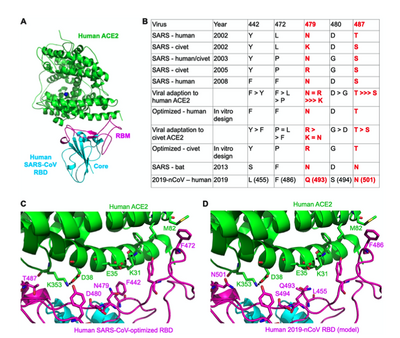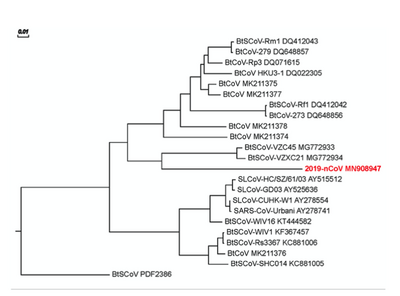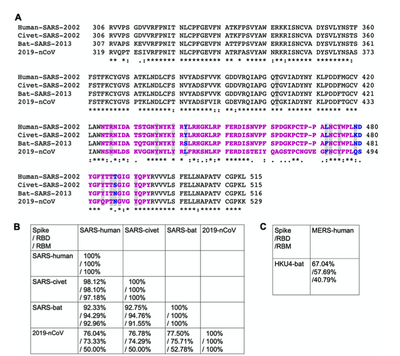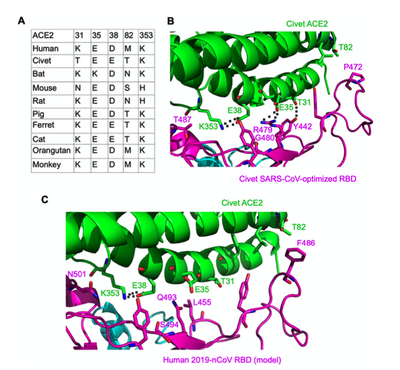Aiden Burnett Week 3
Purpose
To familiarize myself with the conventions of primary research texts & journal clubs. More specifically to analyze and prepare a journal club presentation on the Wan et al. paper
Methods & Results
Definitions
- Epidemic- Occurring suddenly in numbers clearly in excess of normal expectancy, said especially of infectious diseases but applied also to any disease, injury or other health related event occurring in such outbreaks. (Biology Online n.d.)
- Angiotensin- A family of oligopeptides known for their regulation of blood pressure. (Biology Online n.d.)
- Phylogeny- The evolutionary history or development of a group of organisms, such as a tribe or a racial group. (Biology Online 2020)
- Dipeptide(dipeptidyl)- An organic compound formed when two amino acids are joined by a peptide bond (Biology Online n.d.)
- Radial Phylogram- A phylogram is a phylogenetic tree that has branch lengths proportional to the amount of character change. Radial representations use a visual circle to project unrooted trees. This layout is similar to the circular layout but one major difference is that branches can be expanded and nodes can be placed in such a way that clusters or neighbors can be easier visualized. (Pavlopoulos et al. 2012, page 5)
- Salt Bridge- an electrical connection between two cells which acts as a source of spectator ions that can migrate into each of the half cells to preserve neutrality. (Wenzel 2020, page 1)
- Steric (interference)- Pertaining to stereochemistry. Steric hindrance, interference with or inhibition of a seemingly feasible reaction (usually synthetic) because the size of one or another reactant prevents approach to the required interatomic distance. (Biology Online n.d.)
- Orthologue(orthologous genes)- Genes related by common phylogenetic descent and usually with a similar organization; contrast with paralogous genes. (Lackie 2007 p. 304)
- Resevior- Any person, animal, arthropod, plant, soil, or substance (or combination of these) in which an infectious agent normally lives and multiplies, on which it depends primarily for survival, and where it reproduces itself in such manner that it can be transmitted to a susceptible host. (Educational Media Group 2005)
- Putative- In biology, the term is commonly used to describe an entity or a concept that is based on what is generally accepted or inferred even without direct proof of it, meaning it denotes something, like an inference or a supposition, that is accepted because it is deemed to be the case or what has been commonly believed even without solid evidence.(Biology Online 2020)
Article Outline
Importance
By applying what we know about the sequence of the SARS-CoV2 spike protein to predictive frameworks developed by studying SARS-CoV, medical researchers can gain insights into the mechanism of infection and host range of the novel coronavirus. This, as well as data gained using the same framework, can be of use to the medical research community as well as policy makers.
Introduction
- They begin by summarizing the state of the Covid-19 pandemic, then outbreak, as of the January 22nd, 2020.
- At this point there had been more than 500 confirmed cases and at least 17 deaths in China, as well as reports of confirmed cases elsewhere.
- They note that many of the symptoms of 2019-nCoV are similar to SARS-CoV, which had small but alarming outbreaks in 2002-'03 and 2003-'04.
- Both viruses are believed to have entered human hosts at animal markets in Southern China.
- The natural and intermediate reservoirs of SARS-CoV are believed to be bats and palm civets respectively.
- This makes them likely candidates for these roles for 2019-nCoV.
- Coronaviruses come in 4 Genera
- 2019-nCoV and SARS-CoV are both members of the beta genera.
- Past structural studies of theirs have aimed to develop "atomic-level iterative framework of virus-receptor interactions". (Wan et al. 2020) These frameworks can hopefully aid in:
- epidemic surveillance and modelling
- predicting species-specific receptor usage
- identifying animal reservoirs in an effort to limit future outbreaks.
- This study applies their previously developed predictive framework to gain insights into the receptor interactions and reservoirs of 2019-nCoV.
- In other words they were able to use what they learned about SARS-CoV to deduce how 2019-nCoV infects our cells on an atomic level, as well as narrow down the possible animals which could have brought this virus from bats to humans.
Results
Wan et al. Figure 1
Wan et al. Figure 2
- This is a phylogenetic tree developed by comparing the spike protein sequences of beta genus lineage b coronaviruses. The result of this is to illustrate that the spike protein of SARS-CoV-2 is strongly related to other coronaviruses in this genus.
Wan et al. Figure 3
- This is a sequence comparison of 2019-nCoV and SARS-CoV. The result is to illustrate the various related residues.
Wan et al. Figure 4
Methods
- Structural analysis was conducted on the spike proteins of various strains of SARS-CoV & 2019-nCoV, as well as receptor angiotensin-converting enzyme 2 (ACE2), from a range of hosts.
- Phylogenetic analysis was performed to investigate and visualize the heredity of 2019-nCoV.
- Protein sequence alignment was performed using the Clustal Omega program, as part of an effort to compare similar coronaviruses from different hosts and thereby determine the natural and intermediate reservoirs for 2019-nCoV.
Scientific Conclusion
Their works narrows down the origins of SARS-CoV-2. We now know that the natural reservoir is likely bats. We also know that the intermediate reservoir is likely palm civets, but could also be pigs, ferrets, cats, and nonhuman primates. This is because the virus recognizes the ACE2 from these species.
I think that the important implications of their work extend to pandemic modelling, viral interaction, and ecological maintenance. First we now have had a chance to test the reiterative frameworks developed by studying SARS-CoV, which will help researchers fine tune these models and methods of modelling for future outbreaks. Second, we have gained more understanding of SARS-CoV-2's method of interaction with our ACE2 receptors. This may be of use to the medical research community. Lastly, my interest in ecology leads me to focus on the implications for managing the Wildland Urban Interface (WUI). People love living in these areas but the costs of managing them are staggering, and each person's carbon footprint is much larger than it would be in an urban setting. The increased exposure to animal reservoirs in the WUI simply adds on to the complications of managing these areas. The research that has been done here in identifying likely animal reservoirs could be of use for researchers looking to prevent future outbreaks by minimizing or altering our interactions with these animals
Given their understanding of the interaction between the viral spike protein RBD and host receptor ACE2, I would like to see these researchers look into possible methods of interrupting this interaction. To my understanding this interaction is necessary for the fusing of the viral and host cell membranes, and therefore disruption could be a method of preventing infection.
Critical Evaluation
My biggest issue with this paper is that it felt, to me, extremely dense. I gathered that this was clearly meant for professionals with a wealth of prior knowledge but even with the education I do have I had to reread most statements several times to simply parse what they were saying. Accessibility aside, I thought that the work they did was very clever and done well. Their conclusions seemed reasonably well supported given their extensive work in comparing similar structures, locations, and residues on the spike proteins and ACE2 interfaces. I thought that it would have been a leap to name palm civets as the definite intermediate reservoir of SARS-CoV-2, and was please to see that they recognized that this distinction could still be held by a number of species.
Acknowledgments
- I messaged by partner Macie Duran over text and we plan on meeting before class to discuss our figure (figure 2).
- I linked to Nathan Beshai's uploads of the Wan et al. figures, rather than uploading duplicates of the same images. His assessments of the figures were not referenced.
- The text used for the definitions was copied directly from each of the referenced sources.
- Except for what is noted above, this individual journal entry was completed by me and not copied from another source.
Aiden Burnett (talk) 23:42, 23 September 2020 (PDT)
References
- Wan, Y., Shang, J., Graham, R., Baric, R. S., & Li, F. (2020). Receptor recognition by the novel coronavirus from Wuhan: an analysis based on decade-long structural studies of SARS coronavirus. Journal of virology, 94(7). DOI: 10.1128/JVI.00127-20
- OpenWetWare. (2020). BIOL368/F20:Week 3. Retrieved September 22, 2020, from https://openwetware.org/wiki/BIOL368/F20:Week_3
- Epidemic Definition and Examples - Biology Online Dictionary. (n.d.). Retrieved September 23, 2020, from https://www.biologyonline.com/dictionary/epidemic
- Angiotensin Definition and Examples - Biology Online Dictionary. (n.d.). Retrieved September 23, 2020, from https://www.biologyonline.com/dictionary/angiotensin
- Phylogeny Definition and Examples - Biology Online Dictionary. (2020, February 24). Retrieved September 23, 2020, from https://www.biologyonline.com/dictionary/phylogeny
- Dipeptide Definition and Examples - Biology Online Dictionary. (n.d.). Retrieved September 23, 2020, from https://www.biologyonline.com/dictionary/dipeptide
- Pavlopoulos, G. A., Soldatos, T. G., Barbosa-Silva, A., & Schneider, R. (2010). A reference guide for tree analysis and visualization. BioData mining, 3(1), 1. https://doi.org/10.1186/1756-0381-3-1
- Wenzel, T. (2020, July 14). Libretexts 5: Electrochemical Cells. Retrieved September 23, 2020, from https://chem.libretexts.org/Bookshelves/Analytical_Chemistry/Supplemental_Modules_(Analytical_Chemistry)/Analytical_Sciences_Digital_Library/Active_Learning/In_Class_Activities/Electrochemical_Methods_of_Analysis/02_Text/5._Electrochemical_Cells
- Steric Definition and Examples - Biology Online Dictionary. (n.d.). Retrieved September 23, 2020, from https://www.biologyonline.com/dictionary/steric
- Lackie, J. M. (Eds.). (2007). The dictionary of cell and molecular biology (p. 304). ProQuest Ebook Central https://ebookcentral-proquest-com.electra.lmu.edu
- Educational media group. (2005). Infection Control. Retrieved September 23, 2020, from https://emedia.rmit.edu.au/infection_control/content/1_Reservoir/01_rese_de.htm
- Putative - Definition and Examples: Biology Online Dictionary. (2020, May 29). Retrieved September 23, 2020, from https://www.biologyonline.com/dictionary/putative
User Page
Template
Course Homepage
Weekly Assignments
- Week 1 Assignment
- Week 2 Assignment
- Week 3 Assignment
- Week 4 Assignment
- Week 5 Assignment
- Week 6 Assignment
- Week 7 Assignment
- Week 8 Assignment
- Week 9 Assignment
- Week 10 Assignment
- Week 11 Assignment
- Week 12 Assignment
- Week 14 Assignment
Individual Journal Pages
- Aiden Burnett
- Aiden Burnett Week 2
- Aiden Burnett Week 3
- Aiden Burnett Week 4
- Aiden Burnett Week 5
- Aiden Burnett Week 6
- Aiden Burnett Week 7
- FoldamerDB Review
- Aiden Burnett Week 9
- Aiden Burnett Week 10
- Aiden Burnett Week 11
- Aiden Burnett Week 12
- Aiden Burnett Week 14



